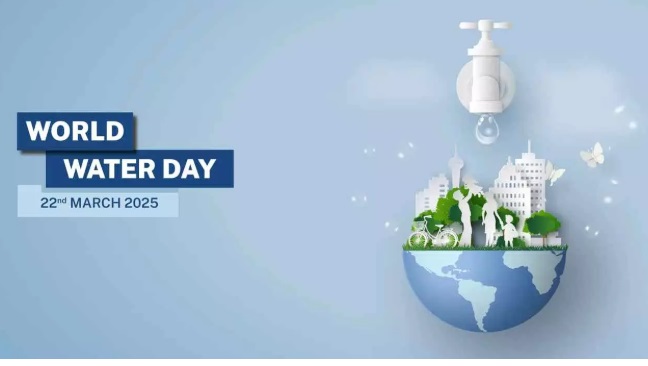World observed Water Day on March 22nd
884 million people do not have access to safe water
(Dr N Khaleel)
The idea of observing World Water Day internationally was formulated at the United Nations
Conference on Environment and Development (UNCED) held in Rio de Janeiro in 1992.
More than 70 percent of the Earth we live on is water. However, only a very small part of this
is clean water. Only about 2.7% of the total water on the planet is clean water, of which
75.2% is frozen in the form of ice in the polar regions, and another 22.6% is underground.
The rest of the water is found in lakes, rivers, the atmosphere, air humidity, soil moisture, and
tree sap. Moreover, only a very small amount of water can be used for human consumption
and other purposes in lakes, rivers, and groundwater. Of the clean water available in the
world, less than 1% (or about 0.007% of the total water available on Earth) is Only) Water is
directly useful for human consumption. Every day, we need at least 30-50 liters of clean, safe
water. But, still, 884 million people do not have access to safe water. Every year, 1,500 cubic
kilometers of wastewater is generated worldwide. Waste materials and wastewater can be
reused for energy production and agricultural purposes. But generally, this does not happen.
In developing countries, due to lack of appropriate regulations and resources, 80 percent of
waste is disposed of without being recycled. Growing population and industrial development
are also the source of new types of pollution. In the same proportion, the need for clean water
is increasing. Due to this, both present and future threats to human health and environmental
cleanliness is looming; There is a serious shortage of clean water for drinking and
agricultural needs. However, water pollution is not uncommonly mentioned as an ‘urgent
issue’. The fear is that summer is coming. Water scarcity is a concern. People are seen
standing in long lines with water bottles. And the water problem is so widespread. These are
not all the problems faced in areas where water is not available. If the earth is thirsty and
waiting for a drop of water, how much more so are humans! We have to walk miles and miles
for a drop of water that soothes our throats. It is a miserable situation to drink dirty water
from puddles and ditches in the absence of clean water. The share of saltwater in the
earth’s water is 97 percent. The remaining 69 percent is snowfall and ice. Only 0.008 percent
of the water on Earth is fresh water. The Johns Hopkins University School of Public Health
in Chicago has warned that 48 countries will face severe water shortages by 2025. 3.575
million people die every year from water-related diseases. Diarrhea accounts for 43 percent
of water-related deaths. 84 percent of these deaths are among children under the age of 14. 98
percent of these deaths occur in developing countries. Half of all hospital admissions
worldwide are for water-related diseases. Less than one percent of the water on Earth is
available for immediate human consumption. A person living in a slum in a developing
country uses the same amount of water as an American takes a bath in a day. The poor living
in slums pay 5-10 times more per liter of water than the rich in the same city. A person can
go for weeks without food. But a person can only go for a few days without water. Every 15
seconds, a child dies from a water-related disease. Millions of women and children spend
hours a day fetching water from far-off places. Water is a divine medicine in the prevention
of diseases. Water is formed by the combination of hydrogen and oxygen in the atmosphere.
When these two gases combine, liquid water is formed. We use water in many ways in our
daily lives. Using water has the potential to reduce many diseases. Imagine a world without
water. There would be no green trees, flowing rivers, living creatures, or vast oceans.
Without these, the earth would be like a dry lump of soil. This day has been set aside to
recognize the value of such precious water and to create awareness about its waste. The
United Nations has decided to mark March 22 every year since 1993. If you know some facts
about water on our earth, you will understand how valuable it is. The amount of water that
was present when the earth was formed is still the same. It has neither increased nor
decreased. But the population of those who use that water has increased exponentially. That
is why millions of people around the world are struggling for water. The water on earth
evaporates in the sun, turns into clouds, falls as rain, soaks into the ground, and mixes with
the ocean, changing into different forms. Three-quarters of the earth is water. But 97 percent
of it is salt water. Only 3 percent is fresh water. Of this, 2 percent is in the form of ice. Of the
remaining one percent of water, 0.59 percent is underground, while the rest flows in rivers
and lakes.
We are not only using the available water sparingly, but we are also polluting it. More than
500 freshwater rivers in the world have been polluted. More people have died from polluted
water than from major wars in the world. 4 million people die every year from drinking
polluted water. While a person in America uses 500 liters of water per day for their needs, a
person in the African country of Gambia uses only 4.5 liters of water per day. In many
countries like Gambia, there is no water even for drinking. What should we do? If you see
water being wasted from taps anywhere, immediately turn them off. Stop taking a shower and
take a bath with a bucket of water. This can save 150 liters of water per day. Do not leave the
tap in the sink running even when you brush your teeth. Doing this wastes 200 liters of water
per month. A toilet flush uses about 8 liters of water. Take two one-liter bottles, fill them with
sand or small stones and flush them down the toilet. This will save two liters of water per
use. Instead of throwing away the water in the aquarium, pour it on the plants. If there are
leaks in the pipes, stop it. This will save 300 gallons of water per month. It takes 300 liters of
water to make the paper used in a newspaper. Water is very important for living things after
air. Therefore, water resources should be used sparingly.










